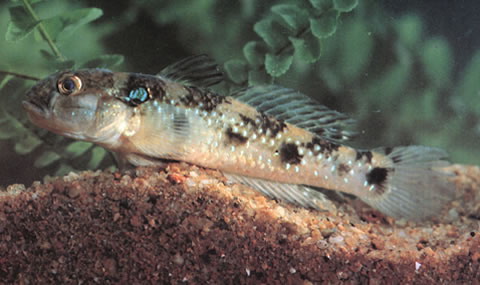| Gobiidae (Gobies), subfamily: Gobiinae |
| 18.3 cm TL (male/unsexed); max.weight: 51.6 g |
|
demersal; freshwater; brackish; marine, amphidromous |
| Indo-West Pacific. Freshwater records from Madagascar by Pellegrin were based on juveniles of unidentified species (Ref. 4343). |
|
Dorsal spines (total): 6-7; Dorsal soft rays (total): 9-10; Anal spines: 1-1; Anal soft rays: 9-9. Characterized by pale grey body with five diffuse brown saddles along back; midside with 4-5 diffuse brown blotches; head and body with scattered white spots; presence of diagnostic greenish patch behind upper edge of operculum; rounded caudal fin; longitudinal scale series 25-26; scales absent on head except upper half of opercle and predorsal fully scaled; mainly ctenoid body scales; depth of body 5.3 in SL (Ref. 90102). |
| Occur along coastlines and in estuaries and harbors. Usually found in brackish tidal waters. Feed on invertebrates. Found to contain tetrodotoxin (TTX) and anhydrotetrodotoxin (anh-TTX) which causes paralytic food poisoning (Ref. 54777). Marketed fresh in Mekong delta (Ref. 12693). |
|
Least Concern (LC); Date assessed: 11 March 2015 Ref. (130435)
|
| poisonous to eat |
Source and more info: www.fishbase.org. For personal, classroom, and other internal use only. Not for publication.

